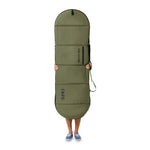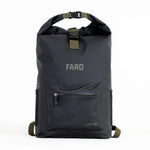Ever wondered just how the surfboards you ride are made? Choosing the right surfboard can make all the difference in your surfing experience. Not only is the type of surfboard you ride important, but the material used in its making also plays a big role in the waves. In this post, we’ve broken down the science behind the making and types of materials used in a surfboard. Let’s dive in!
Anatomy of Surfboards
Before diving into a surfboard's making and material, let's discuss the anatomy of a board. Here are the key components of a contemporary surfboard:
- Deck: The deck is the top surface of the surfboard where the surfer stands while riding the waves. It is usually padded with foam or traction pads for grip and comfort.
- Bottom: The bottom of the surfboard is the part that comes in contact with the water. Different bottom contours, such as concave, flat, or vee, influence the board's speed and stability.
- Rails: Rails are the edges of the surfboard in between the deck and the bottom. Different rail shapes and designs impact the board's performance and how it responds to the wave.
- Tail: This is the backend of the board. The tail of the surfboard plays an important role in helping the rider control the board's direction. The shape and size of the tail differ depending on the surfing conditions and the surfer's style.
- Fins: Fins are attached to the tail, on the bottom of the surfboard, and act as stabilizers, providing control and directionality. Different fin setups, including single fin, twin fin, thruster, and quad, offer a unique surfing experience.
- Core: The core is the internal skeleton of the board. It gives the board structure.
Making Of a Surfboard
There is no one way to make a surfboard. They can be made within minutes in a factory or take days upon days to be hand-crafted by a master carver. Making a surfboard involves a series of steps that demands precision, skill, and attention to detail. Here is a general overview of how surfboards are made:
- Shaping: The first step in surfboard making is shaping. Traditionally, surfboards were shaped by hand using tools such as saws, planers, and sanders. After choosing the material for the core, an experienced shaper will carve out the board's outline and contour to create a functional and aesthetically pleasing surfboard. Each step in the making of a surfboard is important; however, it is the shaping of the board that holds the most weight.
- Glassing: Once the surfboard is shaped, it is time for the glassing process. This process helps the surfboard maintain its hard and surfable disposition. A fiberglass cloth is laid over the board's core, and resin is applied to bond the fiberglass to the foam. Without glassing, the board would be destroyed in a matter of minutes in the ocean.
- Sanding and Finishing: After the glassing process, the surfboard goes through sanding to smooth out imperfections and create a polished finish.
- Fins and Leash Installation: After the final touches, including painting and decorating the board, fins, and a leash plug are added to the bottom of the board.
Types of Surfboard Materials
There are quite a few materials used in the making of a surfboard. Each material offers a different set of characteristics in terms of performance, durability, and weight. Here we have a list of the most commonly used surfboard materials:
Polyurethane (PU) Foam:
Polyurethane foam cores are lightweight and easily shapeable, making them the most used foam choice among board manufacturers. PU foam is typically glassed with polyester resin, resulting in a durable and responsive surfboard. This foam can be easily shaped into custom designs for different types of surfboards, and its rigidity can also be adjusted during production. It's a waterproof material that keeps its form over the years.
Expanded Polystyrene (EPS) Foam:
EPS foam cores are known for their buoyancy and lightweight properties. Surfboards made from EPS foam are more environmentally friendly and offer increased floatation, making them ideal for beginners and small-wave conditions. This foam is more rigid and denser than Polyurethane, making it a perfect material for longboards.
Resin:
Two main types of resins are used to bind a board to a fiberglass sheet: Polyester Resin and Epoxy Resin.
Polyester resin is the most common and affordable resin option. Polyester surfboards hold a little more weight than epoxy boards and are excellent for skilled surfers
Epoxy resin is often used as an alternative to polyester resin in surfboard manufacturing. Epoxy boards are lighter, more durable, and have a higher strength-to-weight ratio compared to traditional polyester boards.
Surfboard Accessories
Just getting a surfboard isn't enough. To make sure you have the best experience riding the waves out in the ocean, you need to know what accessories and attachments you need to go along with your surfboard. Some essential surfboard accessories include:
- Leash: A leash is attached to the leash plug at the tail end of the surfboard. A surfboard leash is a vital safety accessory that connects the surfer to the board and prevents the board from drifting away if the surfer suffers a wipeout.
- Wax: Surfboard wax is applied to the board's deck to provide traction and prevent slipping while standing up and maneuvering on the waves. Applying a coat of surfboard wax onto the board is a good rule of thumb before heading into the water.
- Fins: Fins come in various shapes and sizes, allowing surfers to customize their boards for different surfing conditions and styles. While surfboards have fins attached, having a few extra on hand is always a good idea.
- Surfboard Bag: A surfboard bag protects the board during transport and storage, safeguarding it from dings, scratches, and UV damage. Surfboard cases and bags, like those offered by FARO, make the hassle of transporting your board to and from the beach much easier. FARO offers the best surfboard bags on the market, making your surfing adventure all the more fun. You can look at their high-quality surfboard cases and bags HERE.

Conclusion
In conclusion, making surfboards involves a blend of craftsmanship, innovation, and passion. From shaping and glassing to adding fins and accessories, every step in the surfboard-making process contributes to creating a functional and high-performance board. Whether you are a novice rider or a seasoned pro, knowing the materials used and the process behind building a surfboard can help you make better decisions about the type of board you want to ride into the ocean.





